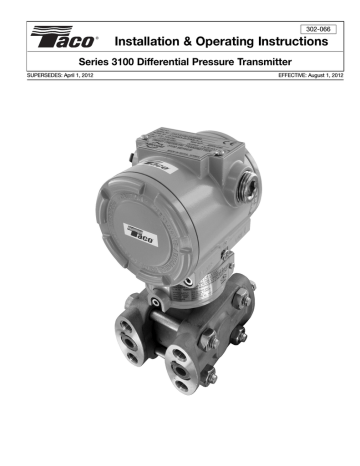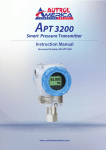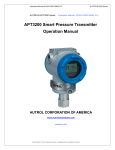advertisement

5.2.1 Warning:
DANGER: Explosion can result in death or serious injury. Do not remove the transmitter covers in explosion-proof environments when the circuit is powered. Both transmitter covers must be fully engaged to meet explosion-proof requirements.
DANGER: Electrical shock can result in serious injury. When installing transmitters in close proximity of high voltage sources (near power lines) the transmitter leads can be subject to high voltages.
Avoid contact with the leads and terminals.
5.2.2 Current to Passive Mode Configuration:
For multi-drop mode the current output must be configured as passive mode. Please disregard any other messages shown on HHT.
5.3 Configuration Data Review:
Before operating the transmitter make sure the configuration data on the nameplate matches the application.
5.4 Configuration Verification:
Before the transmitter is ready for service, the configuration must be checked to confirm the settings are configured for the application.
5.4.1 Process Variable:
There are two process variables in the 3100 Smart Pressure
Transmitter. The primary variable and temperature compensated SV
(Second Variable), the PV value outputs the 4~20mA analog value.
5.5 Basic Setup:
The correlation variable must be configured before operating the transmitter.
5.5.1 Select Sensor Range:
The pressure range must be selected when ordering the pressure transmitter.
5.5.2 Set Output Units:
Select from the following engineering units:
Volumetric Flow Unit -
CubicFeet/min, Gallons/min, Liters/min,
ImperialGallons/min, CubicMeter/hr, Ft/s, meters/s,
Gallons/s, mGallons/day, Liters/s, mLiters/day, CubicFeet/s,
CubicMeter/s, CubicMeter/day, ImperialGallons/hr,
ImperialGallons/day, NormalCubicMeter/hr, NormalLiter/hr,
StandardCubicFeet/min, CubicFeet/hr, CubicFeet/day,
CubicMeters/min, Barrels/s, Barrels/min, Barrels/hr,
Barrels/day, Gallons/hr, ImperialGallons/s, Liters/hr,
Gallons/day
Mass Flow -
Grams/s, Grams/min, Grams/hr, Kilograms/s,
Kilograms/min, Kilograms/hr, Kilograms/day,
MetricTons/min, MetricTons/hr, MetricTons/day, Pounds/s,
Pounds/min, Pounds/hr, Pounds/day, ShortTons/min,
ShortTons/hr, ShortTons/day, LongTons/hr, LongTons/day
Pressure kPa, mmH2O, InH2O, InHg, FtH2O, mmHg, psi, bar, mbar, g/cm 2 , Kg/cm 2 , Pascals, MPa, torr, ATM
Miscellaneous -
%
Time -
Min, sec, hr, days
Mass -
Grams, kilograms, metric tons, pounds, short tons, long tons, ounce
Volume -
Gallons, liters, imperial gallons, cubic meters, barrels, bushels, cubic yards, cubic feet, cubic inches, bbl liq, normal cubic meter, normal liter, standard cubic feet, hectoliters
5.5.3 4-20mA Configuration:
Set the Zero and Span for the 4~20mA analog output.
5.6 Detailed Setup:
5.6.1 Set Fail Mode:
When the sensor or microprocessor is not operating properly, the transmitter will output 3.75mA or 21.75mA based on the Fail
Mode setting.
5.6.2 Set Dampening Time:
The Dampening Seconds value changes the response time of the transmitter to smooth out variations caused by rapid process changes. Determine the appropriate dampening setting based on the required response time, signal stability, and other requirements of your system.
The Dampening Seconds can be set from 0-60 seconds; the default dampening value is 1.0 second.
Figure 17
5.7 Configuration of Information Variable:
5.7.1 Set Tag:
Tags are an easy way to classify transmitters in multi transmitter application. Tags can use 8 words/numbers.
5.7.2 Set Messages:
When using several transmitters, the user can define each transmitter by using 32 words/numbers. This message is saved in EEPROM.
5.8 Diagnostics and Service:
5.8.1 Loop Test:
The Loop Test verifies the output of the transmitter, the integrity of the loop, and the operations of any recorders or similar devices installed in the loop. The following procedures are required for a loop test.
• Connect a reference meter to the transmitter.
• Select the Loop Test on the HHT and operate the Loop Test.
• Select current output (4mA/20mA/etc.)
• If the readings match, then the transmitter and the loop are configured and functioning properly. If the readings do not match, then you may have the current meter attached to the wrong loop, there may be a fault in the wiring, the transmitter may require an output trim, or the current meter may be malfunctioning.
5.9 Calibration:
The scale is implemented by calibrating the transmitter. Trim function has several calibration functions. Smart transmitters operate differently than analog transmitter. A smart transmitter uses a microprocessor that contains information about the sensor's specific characteristics in response to pressure and temperature for calculating the process variable. 4-20mA configuration sets the
13
advertisement
Related manuals
advertisement
Table of contents
- 4 Introduction
- 4 Using This Manual
- 4 Overview of Transmitter
- 4 Software Compatibility
- 4 Handling Cautions
- 5 Unpacking Transmitters and Specifications Check
- 5 Models and Specifications Check
- 5 Storage
- 5 Selecting Installation Locations
- 5 Calibration after Installation
- 5 Pressure Connections
- 5 Waterproofing Cable Conduit Connections
- 5 Restrictions on Use of Radio Transceiver
- 5 Installation Resistance Test and Dielectric Strength Test
- 6 2.10 Explosion-Proof Transmitters
- 6 2.11 EMC Conformity Standards
- 6 Transmitter Functions
- 6 Overview
- 6 Safety Messages
- 6 Warning
- 7 Fail Mode Alarm
- 7 EEProm-Write Enable/Disable Mode Jumper
- 7 Configuration of Alarm and Security Jumper Procedures
- 8 Configuration of Zero and Span Procedures
- 9 Commissioning on the Bench with HHT
- 10 Installation
- 10 Overview
- 10 Safety Messages
- 10 Warning
- 10 Commissioning on the Bench with Hand-Held Terminal
- 10 General Considerations
- 10 Electrical Considerations (Power Supply)
- 10 Wiring
- 12 Mechanical Considerations
- 12 Environmental Considerations
- 12 On-line Operation
- 12 Overview
- 12 Safety Messages
- 13 Configuration Data Review
- 13 Configuration Verification
- 13 Basic Setup
- 13 Detailed Setup
- 13 Configuration Variables Setup
- 13 Diagnostics and Services
- 13 Calibration
- 14 Maintenance
- 14 Overview
- 14 Safety Messages
- 14 Hardware Diagnostics
- 15 Hardware Maintenance

